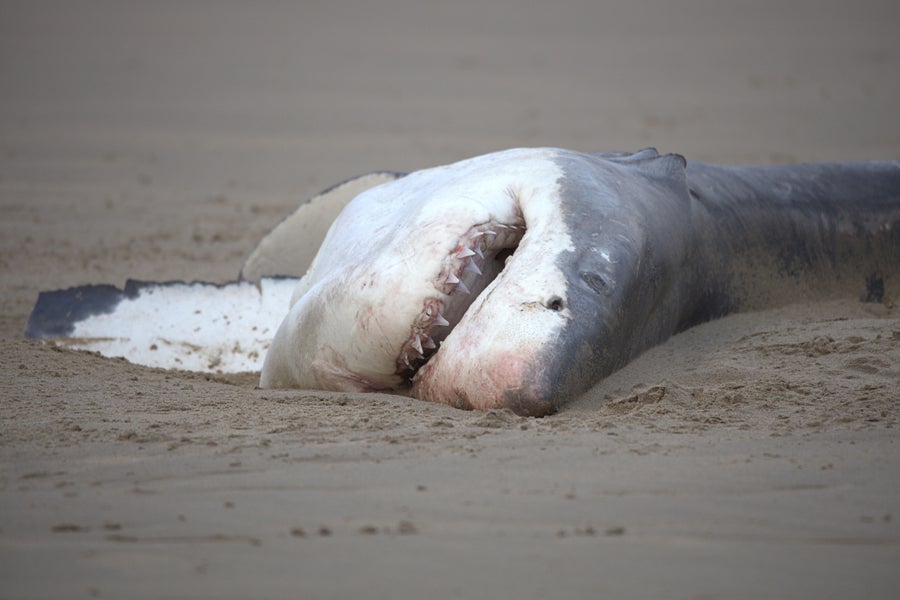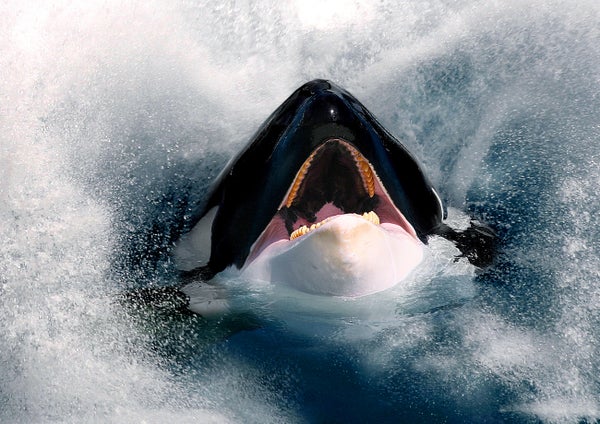An infamous orca killed a great white shark by itself last year in South Africa and devoured the shark’s nutritious liver. It’s the first time researchers have made detailed observations of a killer whale preying on a great white shark alone, and the entire attack took less than two minutes.
“While killer whales can hunt large prey individually, this is the first documented instance in South Africa involving white sharks as prey,” says Alison Towner, a senior white shark biologist at the conservation and ecotourism organization Marine Dynamics.* “The surprising element was how quickly the killer whale immobilized and consumed the liver of the shark.”
The killer whale involved is well known in Mossel Bay, South Africa. Dubbed “Starboard” for his bent-to-the-right dorsal fin, this orca has been observed preying on white sharks in the area with its travel partner, “Port,” for years. (Port, another male, has a dorsal fin that bends to the left.)
On supporting science journalism
If you're enjoying this article, consider supporting our award-winning journalism by subscribing. By purchasing a subscription you are helping to ensure the future of impactful stories about the discoveries and ideas shaping our world today.
The researchers aren’t sure why Starboard went after the shark on his own or how frequently this behavior occurs, they report today in the African Journal of Marine Science. Before now Port and Starboard had always been observed working together in attacking white sharks, sometimes leading groups of up to six total orcas in drawn-out pack hunts. Towner and her colleagues previously reported that these hunts usually end in a feast of shark liver for the predatory whales.
But on the afternoon of June 18, 2023, when onshore observers spotted the two orcas, that wasn’t the case. The researchers studying the pair launched a small vessel and followed them. In the killer whales’ wake, they discovered a slick of gore on the ocean surface, accompanied by the smell of shark liver. “Shark liver has a unique and recognizable scent—oily,” Towner says. “Once you’ve encountered it, you won’t mistake it for anything else.”

A great white shark carcass.
Credit: Christiaan Stopforth, Drone Fanatics SA (CC BY)
The slick suggested that the orcas had attacked and killed something. The boat followed the animals, which were swimming apart from each other. Suddenly a great white shark appeared at the surface, with Starboard in hot pursuit. As researchers watched, the orca grabbed the shark’s left fin and thrust forward with its mouth, eviscerating the shark. Several minutes later, observers aboard a nearby shark-diving boat watched as Starboard swam a victory lap by their vessel, holding a bloody piece of shark liver in his mouth.
The shark killed in the attack was also known to biologists. “After 24 years of working with the great white, to see an orca—that, before [this], I loved a lot—killing my preferred shark, I was really stressed, is the minimum that I can say,” says Primo Micarelli, a marine biologist at the University of Siena in Italy who was on the shark-diving vessel. At the same time, he said, he knew the solo attack was unusual and important.
The vanquished shark was a juvenile about 2.5 meters (8.2 feet) long. The next day a slightly larger great white shark measuring 3.55 meters (11.6 feet) long washed ashore nearby, also liverless. This shark may have been the one killed in the first, unobserved attack that left the gory slick, the researchers wrote in their paper.
Port and Starboard are a “gift that keeps on giving,” says Isabella Reeves, a doctoral candidate in marine biology at Flinders University in Australia, who has collaborated with Towner but was not involved in the current research. The whales are rewriting some of what biologists thought they knew about orcas, she says. “I think perhaps what surprises me most is that there seems to be some degree of ‘leadership’ from these two male killer whales during these hunts, which is unusual and not recorded much in the wild,” she says. “Females generally take the lead while hunting.”
Orcas in South Africa are not unique in their shark-hunting tendencies, says Jennifer Tennessen, a senior research scientist at the Center for Ecosystem Sentinels at the University of Washington. In the Pacific Northwest, offshore bands of orcas include a variety of sharks in their diets, she says. But these animals are found far off the coast of Oregon, Washington and British Columbia, so their behaviors are hard to observe, she says.
“There’s much to learn still about how many individuals are involved in these shark predations in South Africa and the frequency of these occurrences,” Towner says. “In fact, there is a whole lot we need to learn about killer whales in this part of the world in general. Most of them are difficult to access as they move at high speed and spend a lot of time away from the coasts. Citizen scientists and drones are contributing such valuable information.”
Editor’s Note (3/20/24): This article was edited after posting to correct the description of the killer whale’s attack being the first of its kind to be observed in detail. The text was previously amended on March 4 to correct the description of Alison Towner’s current position.
